In today’s increasingly energy-dependent world, having a reliable backup power source is not just a luxury but a necessity.
Among various options, a 5500-watt generator strikes an ideal balance between power output and portability, capable of powering several vital home appliances and tools during power outages or while camping off-grid.
This article will delve into the details of what will a 5500 watt generator run, helping you understand its capacity, practicality, and how it can fit into your energy needs.
Given its power output, a 5500-watt generator is a versatile and capable solution for many scenarios. Its vast applications include residential use during blackouts, supporting outdoor events, or providing electricity on construction sites. This equipment can easily manage essential household appliances such as refrigerators, freezers, lights, and even some air conditioning units.
Starting And Running Watts Of A Generator
When considering the operation of a generator, two vital terms come into play: starting watts (also known as peak watts) and running watts (also referred to as rated or continuous watts).
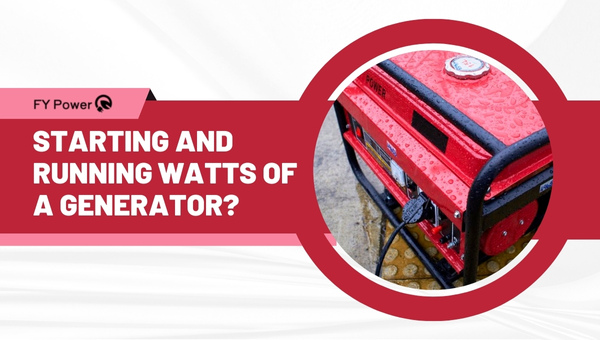
Starting watts represent a generator’s maximum power output to start electric motors. Some appliances, such as refrigerators, air conditioners, and sump pumps, require more energy at startup, often two to three times their running watts. This surge in power demand is momentary, lasting only for a few seconds or minutes.
On the other hand, running watts is the continuous power a generator can supply to keep your appliances or devices operating. A generator can provide this consistent power output over long periods. Most appliances and devices will list their running wattage in their specifications.
Understanding the difference between these two power measurements is crucial for determining the capacity of the generator you need. You’ll want to ensure that your generator can handle the combined starting watts of any appliances that might start up at the same time, as well as the total running watts of all devices you plan to power concurrently.
Also Read: 5W20 and 5W30 Oil: Difference, Uses, Shopping Guide
What Appliances Can A 5500-Watt Generator Run Simultaneously Without Overloading The Generator?
A 5500-watt generator can power multiple appliances simultaneously as long as the total wattage of all the appliances does not exceed the capacity of the generator.
These are some of the appliances that you can run on 5500-watt generators:
- Small window AC unit – 1,200 watts
- Hammer drill – 1,000 watts
- Coffee maker – 1,000 watts
- Small well pump (1/2 HP) – 1,000 watts
- Radiant heater – 1,800 watts
- Washing machine – 1,150 watts
- Refrigerator – 700 watts
- Microwave oven – 1,000 watts
- Dishwasher – 1,500 watts
- Toaster – 850 watts
- Vacuum cleaner – 200 watts
- Smaller electric appliances – 400 watts
- A couple of power tools – 800 watts
- Window AC (10,000 BTU) – 1,200 watts
- Electric water heater – 4,000 watts
- Bench grinder – 1,400 watts
For example, a 5500-watt generator could power a refrigerator, a microwave, and an air conditioner at the same time. However, if these three items combined draw more than 5500 watts, then they will overload the generator and cause it to shut down.
It is important to note that most generators have a surge rating which allows them to supply extra power during startup or short high-demand situations for up to 10 seconds before automatically shutting off.
This means that you may be able to run two or more high-wattage items on your generator without overloading it just long enough to get the job done. However, it is important to monitor wattage draw carefully to avoid overloading your generator and damaging your appliances.
How Long Can A 5500-Watt Generator Run Without Refueling?
The amount of time a 5500-watt generator can run without refueling depends on the size of its fuel tank and how much power it is being used to produce.
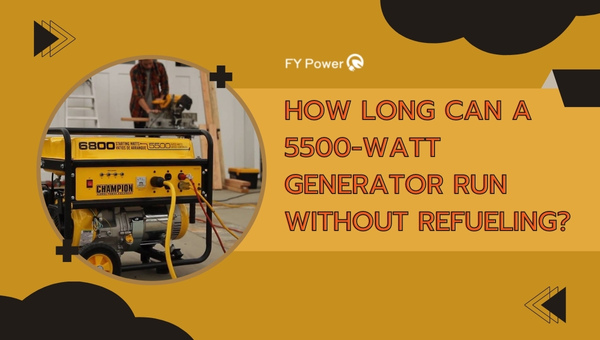
Speaking, most 5500-watt generators will run for 8-10 hours on a full tank of gasoline at 50% load capacity.
If you are running your generator at higher loads or for longer periods of time, you should consult the user manual to determine exactly how long your generator can operate before needing to be refueled.
It is also important to check the oil level of your generator periodically to ensure that it remains at proper levels and is not running too hot. Doing so will help extend its life and performance.
Can 5500-Watt Generators Power Multiple Large Appliances?
Yes, 5500-watt generators are capable of powering multiple large appliances.
However, you should never exceed the generator’s capacity and ensure that all appliances’ total wattage draw does not exceed 5500 watts.
It is also important to monitor your generator’s performance to prevent damage or overloading due to sudden surges in power demand. If you are unsure of how to do this, it is recommended that you contact a professional for assistance.
How Many Amps Does A 5500 Generator Provide?
The number of amperes (amps) a generator can provide depends on the voltage it’s set to output. In the United States, the standard household voltage is approximately 120 volts for typical appliances.
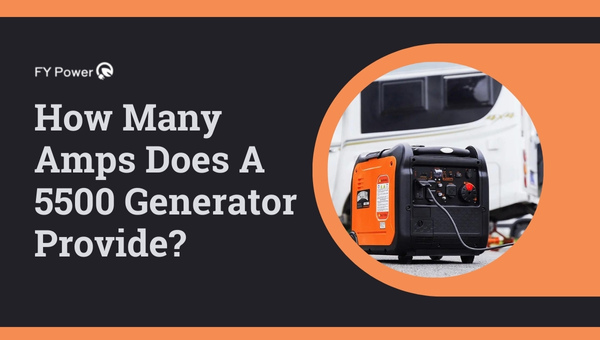
The power capacity of a generator is often given in Watts or kiloWatts. To calculate the number of amps a generator can provide, we can use the formula:
Amps = Watts / Volts
If you have a 5500-watt generator, and it’s supplying power at 120 volts, the calculation would be:
Amps = 5500 Watts / 120 Volts = 45.83 Amps
However, keep in mind that this is a simplified calculation. Many generators can supply power at different voltages, and the actual current (amps) can be different depending on the voltage setting. Also, appliances and other loads can have different power factors, which may affect the real-world current draw.
It’s also worth noting that many 5500-watt generators come with a 240-volt option. In that case, you would still have the same wattage, but the amperage would be halved, meaning:
Amps = 5500 Watts / 240 Volts = 22.92 Amps
Remember, this only represents the maximum capacity. In practical use, you’d likely want to avoid consistently running your generator at its maximum capacity to prolong its life and avoid potential overheating or other issues.
Can A 5500-Watt Generator Power My House?
Whether a 5500-watt generator can power your entire house depends on the total wattage of the appliances and systems you need to power. Here’s how you can figure it out:
Calculate your power needs: Make a list of all the appliances and systems you want to power in the event of a power outage. These may include lights, refrigerators, freezers, furnaces, air conditioners, computers, televisions, etc.
You can typically find an appliance or system’s power consumption (in watts) on its information plate or user manual. If the power consumption is listed in amps, you can convert this to watts using the formula:
Watts = Volts x Amps.
Add up the total: Once you have the power consumption of each appliance or system, add them all up to get the total power consumption.
If your total power consumption is less than 5500 watts, then your generator should be able to power your house. However, keep in mind a couple of important points:
- Starting power vs. running power: Many appliances require more power to start up than they do to run continuously. For example, a refrigerator might require 1200 watts to start but only 800 watts to run. You need to ensure your generator can handle these start-up loads.
- Reserve capacity: It’s generally not a good idea to run a generator at its maximum capacity for extended periods. This can wear out the generator more quickly and increase the risk of it overheating.
- Essential vs. non-essential: You may not need to power everything in your house. Focus on the essentials, like your refrigerator, freezer, furnace, and a few lights and outlets.
Lastly, suppose you plan to connect your generator directly to your house’s electrical system (as opposed to plugging individual appliances into the generator). In that case, you’ll need a transfer switch installed by a professional electrician. This is a safety device that disconnects your house from the power grid before starting the generator, which prevents back feeding that can cause serious accidents.
Can A 5500-Watt Generator Supply Enough Electricity For An RV(Recreational Vehicle)?
A 5500-watt generator is generally sufficient to power most RVs, including the use of air conditioning, lighting, refrigeration, and electronic devices. However, the exact power requirements can vary based on the size of the RV and the electrical appliances you are using.
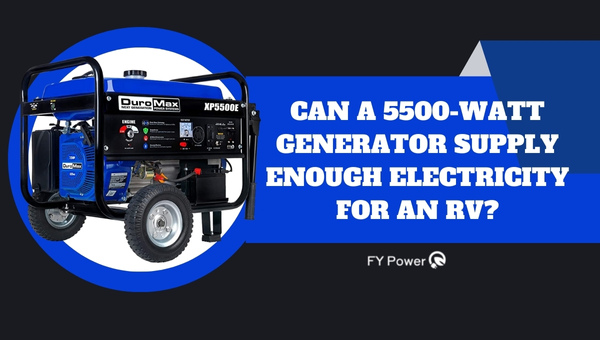
Here’s a general guideline for the power usage of common RV appliances:
- Air Conditioner: Around 1300 to 2000 watts to start, and 300-1500 watts to run, depending on the size and model.
- Refrigerator: Around 600 watts to start and 180-200 watts to run when on electric mode.
- Microwave: Around 1000 watts.
- TV: Around 100-200 watts.
- Lights: LED lights use very little, around 10-15 watts.
- Water heater: If on electric mode, about 1000-1500 watts.
As you can see, even with all appliances running simultaneously, a 5500-watt generator should provide ample power for an RV.
Just as when powering a home, keep in mind that many appliances use more power to start up than they do to run continuously, so you’ll need a generator that can handle these startup loads. Also, to prolong the life of your generator and prevent overheating, it’s best not to run it continuously at its maximum capacity.
Finally, consider the noise level of your generator. In many campgrounds and RV parks, excessively loud generators can be a nuisance to other campers. Many newer models of generators are designed to operate more quietly, making them better neighbors in the campground.
Also Read: 5W30 and 10W30 Oil: Differences, Properties, Uses
Can A 5500-Watt Generator Be Used For Backup Power During An Outage?
Yes, a 5500-watt generator can definitely be used as a backup power source during an outage. Depending on your needs and power consumption, it may power a significant portion of your household appliances or even your entire house.
However, you must prioritize your power usage during an outage, focusing on critical appliances and systems like refrigeration for food storage, heating or cooling systems (depending on the season), necessary lights, and any necessary medical equipment.
Before connecting a generator to your home, remember these important safety guidelines:
- Install a Transfer Switch: This essential safety device prevents your generator from feeding electricity back into the power grid, a phenomenon called “back feed,” which can cause serious accidents or damage. A professional electrician should install a transfer switch in order to prevent electrocution or electrical fire.
- Ventilation: Never operate a generator inside your home, garage, basement, or other enclosed or partially enclosed space, even if the doors and windows are open. Generators can quickly produce high levels of carbon monoxide, which can be deadly.
- Fuel Storage: Store generator fuel in a properly designed container in a cool, well-ventilated space. Gasoline, propane, kerosene, and other types of generator fuel can ignite easily and cause a fire.
- Avoid Overload: Don’t exceed the rated capacity of your generator. Overloading your generator can damage it or appliances connected to it and may cause a fire.
Finally, keep your generator maintained according to the manufacturer’s instructions. Test it regularly to ensure that it will work when you need it.
What Are Some Other Uses For A 5500-Watt Generator Aside From Powering Your Home During An Emergency Situation?
Aside from being a great choice for backup power during an outage, a 5500-watt generator can also be used to provide temporary electricity for camping trips, job sites, or other outdoor activities.
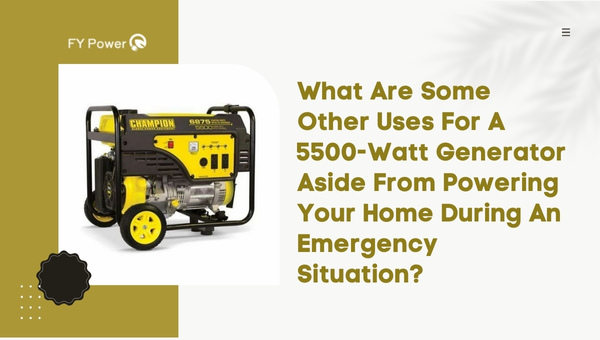
Additionally, this size of generator is often used in construction and remodeling projects as it provides enough power to run larger tools such as saws and drills.
Finally, some people may choose to use a 5500-watt generator as their primary source of electricity if they live off the grid or in an area with unreliable access to the power grid. Whatever your needs may be, a 5500-watt generator is sure to provide you with reliable and efficient power.
What Are Some Of The Benefits Of Owning A 5500-Watt Generator?
The benefits of owning a 5500-watt generator are numerous, including:
- A 5500-watt generator is relatively lightweight and portable when compared to larger units. This makes it ideal for camping trips or other short-term power needs.
- Investing in a 5500-watt generator can save you money on your energy bills if you use it as an alternative source of electricity in certain situations.
- As mentioned above, a 5500-watt generator can be used for various applications, such as powering tools at job sites, providing backup power during outages, or as a primary source of electricity if living off the grid.
- Most generators come with safety features such as overload protection and a voltage regulator. These features will help ensure the safety of you and your equipment when using the generator.
Conclusion
A 5500-watt generator can be a great choice for providing backup power during an outage or for providing temporary electricity for camping trips, job sites, or other outdoor activities.
This size of generator is often used in construction and remodeling projects as it provides enough power to run larger tools such as saws and drills.
Investing in a 5500-watt generator can also save you money on your energy bills if you use it as an alternative source of electricity in certain situations.
Finally, make sure that the generator is equipped with safety features such as overload protection and voltage regulators to help ensure the safety of you and your equipment when using the generator.

